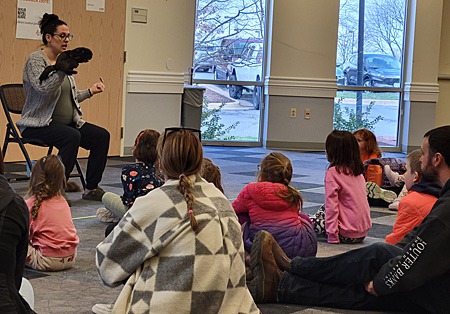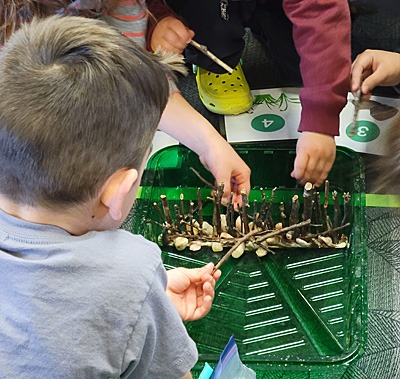Build Like a Beaver Program Was Fun for Everyone
Build Like a Beaver was a family-fun program given by Alison Zak of the Human-Beaver Co-existence Fund on March 10 at Rust Library where 45 attendees learned what a beaver looks like and how they build dams.

Photo by Kim Strader
Alison began with the help of her beaver puppet, Princess Bigtooth Buttercup, showing us that beavers have five fingers that help grasp sticks and five webbed toes to help them swim. Using a replica beaver skull, she pointed out that the eyes, ears and nose are located on the top of the skull so the least amount of them shows as they swim through the water. And what about those teeth – why do they have an orange/brown color? Hint: It is not because they do not brush their teeth. Alison explained that beaver teeth are coated with iron and that they use the front long teeth to chop and the back teeth to chew. Another amazing fact is that beavers have two lips to prevent water from entering their mouth while swimming with a stick.
Alison talked a little bit about a beaver’s tail too. They use it to swim and communicate with others. When beavers smack their tails in the water it is to scare off predators. All the kids had fun clapping their hands as loud as they could to imitate the sound. Alison said the sounds of a real beaver is a whole lot louder, and that she has been scared by the sound before.
After talking about a beaver’s body, Alison explained and demonstrated (with the kids following her every move) the difference between a dam and a lodge. Beavers build dams to block water and lodges to live in. Stella Partheniou Grasso’s book, Five Busy Beavers, ends with all the animals (muskrat, heron, turtle, frog and firefly) gathering in the beaver lodge for a party. While this does not actually happen in nature, it is an enjoyable story that has the kids counting while learning what other wildlife lives in wetlands created by beavers.

Photo by Kim Strader
After the story, we learned how a beaver builds a dam as the kids helped building one together. The layers of the dam, from creek bottom to the top, are:
1. Mud
2. Sticks laid vertical on top of the mud
3. Rocks
4. Grass or cattails
5. Sticks, again, but laid horizontal and woven into the vertical ones
6. More mud to fill in all the gaps
Everyone gathered as Alison poured water to see if the dam worked. She decided we needed to go back to “beavering school” as our dam did not hold the water back as well as a real dam does. Alison pointed out that beaver dams are important to people because they: slow water flow during floods; help prevent/stop erosion; and, filter/clean water as it passes through the dam.
The program concluded with everyone getting the chance to build their own dam with pretzels and chocolate icing. Thank you to the library for displaying books about beavers and many thanks to Alison for presenting such a fun program for all ages!
The post Build Like a Beaver Program Was Fun for Everyone appeared first on Loudoun Wildlife Conservancy.
The post Build Like a Beaver Program Was Fun for Everyone appeared first on Loudoun Wildlife Conservancy.



